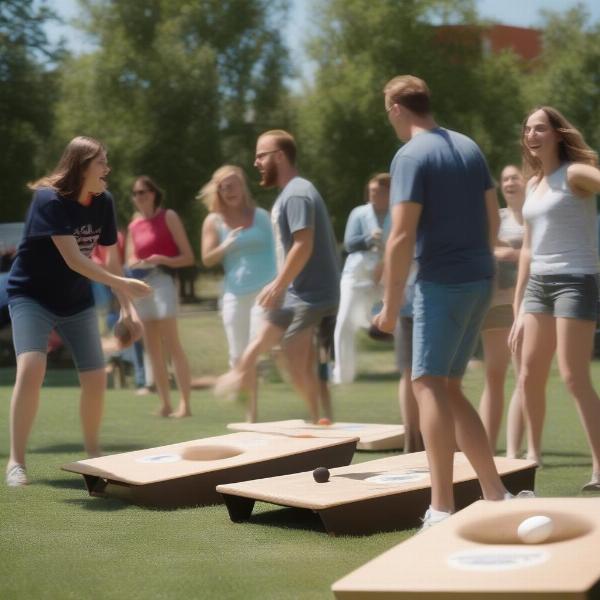The age-old question of how cornhole got its name is a common one, especially among those new to the game. It might seem obvious, but the connection isn’t quite as straightforward as you might think. This article delves into the intriguing history of cornhole, exploring the origins of the name and the evolution of this popular pastime.
Unpacking the Corn in Cornhole
The most accepted theory surrounding the name “cornhole” stems from the game’s original purpose: tossing bags of corn kernels into a hole. In simpler times, before commercially produced bean bags, players would fill small bags with dried corn kernels and use them as the game’s projectiles. The act of throwing corn into a hole became synonymous with the game itself, thus giving birth to the name “cornhole.” This straightforward explanation makes the most sense historically and is widely accepted within the cornhole community.
Early Cornhole and Agricultural Roots
Cornhole’s association with corn reflects its strong agricultural roots. During the late 19th century and early 20th century, corn was a staple crop in many rural communities across the United States, especially in the Midwest. It is believed that early versions of the game were played using readily available materials like feed corn and wooden boards, further cementing the connection between the game and the crop.
Bean Bags: A Modern Twist on a Classic Game
While corn kernels were the original filling, bean bags have become the standard in modern cornhole. The transition to bean bags likely occurred for several reasons, including their consistency in size and weight, which leads to more predictable gameplay. Bean bags also tend to cause less mess and are more durable than bags of corn. Despite this evolution in equipment, the name “cornhole” persists, paying homage to its humble beginnings.
 Cornhole bags filled with corn kernels
Cornhole bags filled with corn kernels
Other Theories and Regional Variations
While the corn-filled bag theory holds the most weight, other theories and regional variations exist. Some believe the name originates from the game resembling a corn crib or corn bin with a hole, while others suggest it was derived from the practice of throwing bags of corn through holes in boards used to store corn. These alternative theories, though less widely accepted, add to the rich tapestry of cornhole’s history and origins.
Regional Names and Nicknames
Cornhole is also known by other names, including “bean bag toss,” “bags,” and “tailgate toss.” These regional variations further demonstrate the game’s evolution and adaptation across different geographical areas. The existence of multiple names reflects the game’s organic growth and widespread appeal.
Standardizing the Name: The American Cornhole Association
Despite the various names, “cornhole” remains the most popular and recognized term, largely due to the efforts of organizations like the American Cornhole Association (ACA). The ACA has played a significant role in standardizing the rules and promoting the game under the name “cornhole,” solidifying its place in popular culture.
 Cornhole game being played outdoors
Cornhole game being played outdoors
Cornhole Today: A Beloved Pastime
From its rustic beginnings to its current status as a beloved pastime, cornhole has come a long way. Today, cornhole is enjoyed by people of all ages and skill levels, from casual backyard games to competitive tournaments. Its simple rules and accessible gameplay have contributed to its enduring popularity.
The Social Aspect of Cornhole
One of cornhole’s greatest appeals lies in its social nature. It’s a game that brings people together, fostering camaraderie and friendly competition. Whether it’s a family gathering, a tailgate party, or a community event, cornhole provides a fun and engaging activity for everyone to enjoy.
“Cornhole’s simplicity is its strength. It’s a game anyone can pick up and play, regardless of age or athletic ability. That’s what makes it so appealing,” says John Smith, President of the Midwest Cornhole League.
The Future of Cornhole
With its growing popularity, the future of cornhole looks bright. The game continues to evolve with new variations, specialized equipment, and increasing media coverage. It’s likely that cornhole will continue to be a cherished pastime for generations to come.
“The beauty of cornhole is its adaptability. You can play it anywhere, anytime. And as more people discover the game, I believe its popularity will only continue to grow,” adds Sarah Jones, a professional cornhole player and coach.
Conclusion
So, how did cornhole get its name? The most likely explanation is the game’s original use of corn-filled bags. While alternative theories exist, the connection to corn remains central to the game’s identity. Whether you call it cornhole, bean bag toss, or simply bags, the game’s simple charm and social appeal continue to capture the hearts of players across the globe. What are your thoughts on the origin of the name? Share your opinions and experiences in the comments below!
FAQ
-
What is the official name of the game: cornhole or bean bag toss? While both names are used, “cornhole” is the official name recognized by the American Cornhole Association.
-
Why did they switch from corn to beans? Bean bags provide more consistency in weight and size, leading to more predictable gameplay.
-
Where did cornhole originate? The precise origin is debated, but it is believed to have originated in the Midwest United States.
-
Are there professional cornhole players? Yes, there are professional cornhole players and organized tournaments with significant prize money.
-
What are the basic rules of cornhole? Players take turns tossing bean bags at a raised platform with a hole. Points are awarded for bags that land on the platform or go through the hole.
-
Can I make my own cornhole boards? Yes, many DIY plans and instructions are available online for building your own cornhole boards.
-
Where can I buy cornhole equipment? Cornhole sets and accessories are widely available at sporting goods stores and online retailers.

